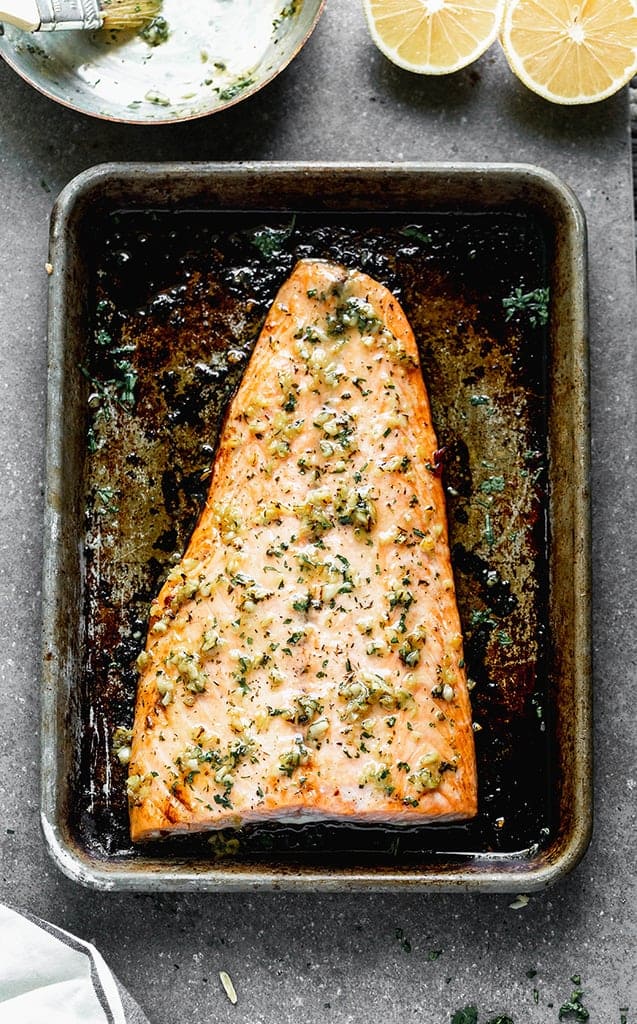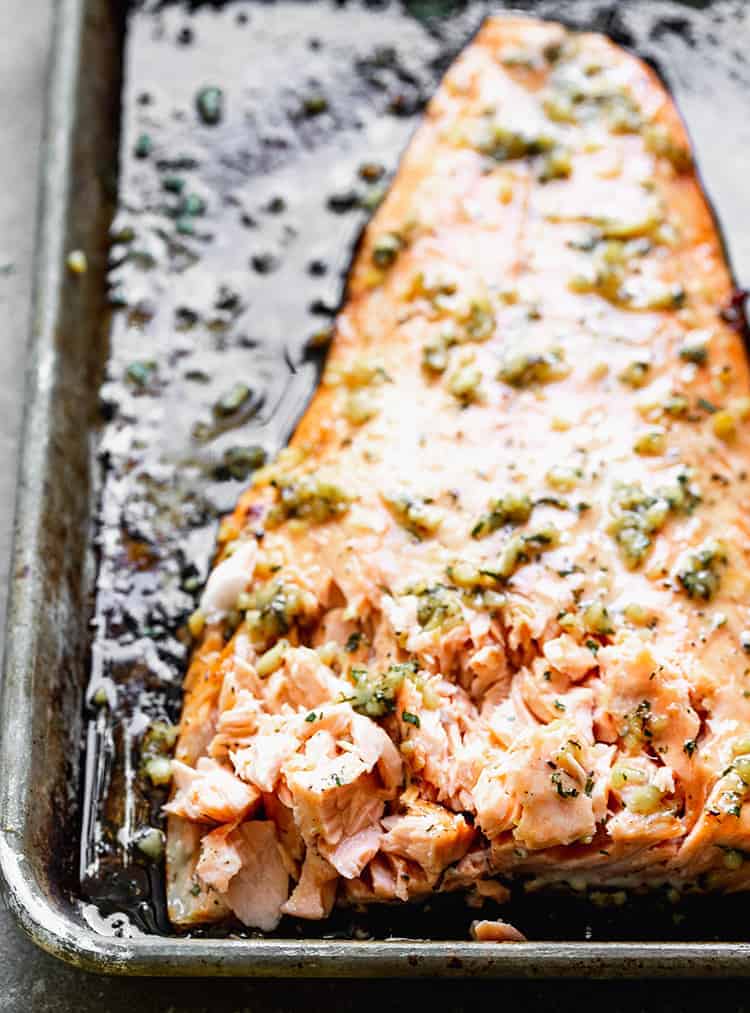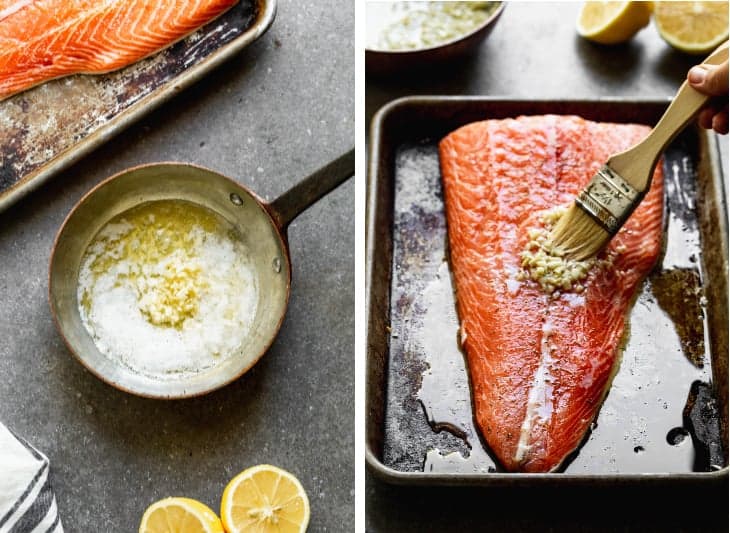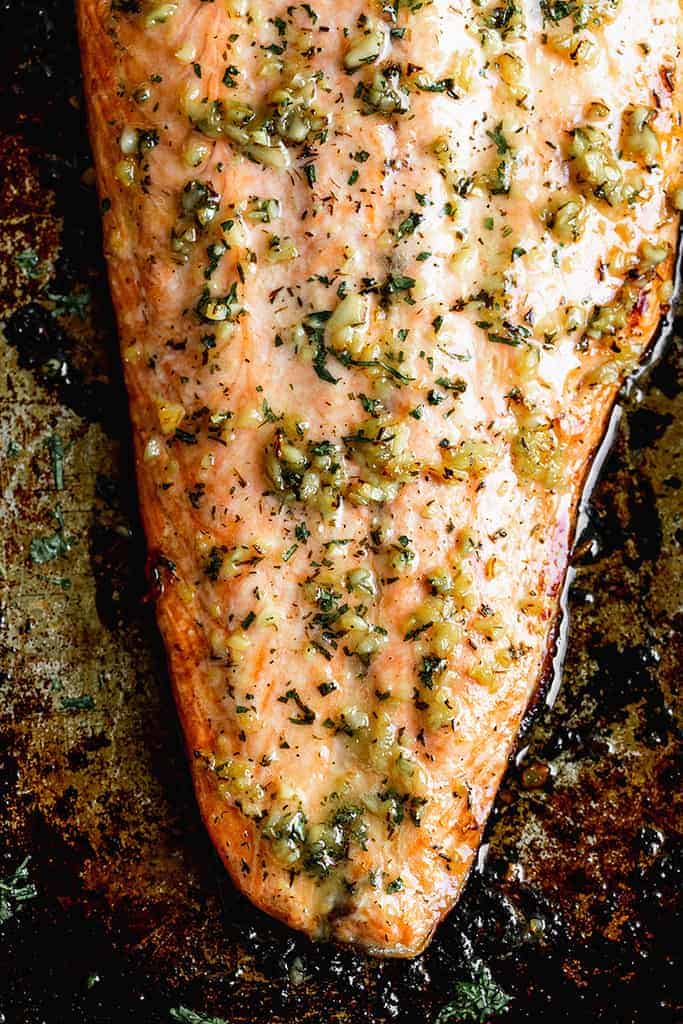How Long To Cook Large Salmon Fillet
The do's and don'ts for making perfectly cooked Baked Salmon on a sheet pan or in tinfoil! This method couldn't be easier, and I've included recipes for my three favorite ways to season salmon, including garlic butter, lemon-dill or cajun seasoning.
Salmon was a Sunday dinner staple at my house growing up. My mom either cooked it in the oven or on the grill and she always served it with Perfect Mashed Potatoes and Roasted Vegetables. She's passed down all her tips and tricks and I'm excited to share them with you!

How to Bake Salmon
Our regular Sunday dinner with my family growing up was always a nice piece of perfectly cooked salmon, with fresh vegetables. It wasn't until I was a little older that I realized how spoiled I was to have salmon for dinner so often, but it's a tradition I'd love to have with my own family as well. Not only is salmon healthy, it's also one of the easiest recipes to make!
Do's and Don'ts for Baked Salmon:
Do buy high quality salmon.
There are several types of salmon, including: King salmon (Chinook), silver salmon (coho), pink salmon (humpback), red salmon (sockeye), and Atlantic salmon. Any of these types of salmon can taste delicious baked in the oven.
Do check for freshness:
Salmon filet– if you are buying a salmon filet at the store, choose a filet with firm flesh. Give it a poke! Gently press the fillet with your finger and if it springs back, this is a good sign. If you'r fingerprint lingers in the fillet, choose a fresher fish. Also, look for a brightly orange-red hue in the fillet and nicely marbled skin. Look for darkening around the edges of the fish or brown/yellow discoloration in the flesh of the fish. These are NOT signs of freshness.
Whole Salmon – First look in its eyes–no really! Take a look at the eyes of the salmon and choose a salmon with clear, bright eyes over cloudy, sunken eyes. Clear eyes is a good indicator of freshness. When you hold the fish, also look for the flesh to feel firm, not floppy.
Smell the fish! This is a huge indicator of freshness! You want to avoid salmon that has a strong fishy smell. It should have a mild, salt-water or sea smell.

Do thaw salmon properly:
Fresh fish- After purchasing fresh fish, store it in the refrigerator until ready to use (it typically should be used within two days). Before baking, be sure to let the fish sit at on the counter until it comes to room temperature. This will allow it to cook more evenly.
Frozen fish- to thaw frozen fish, either let it say in the refrigerator overnight or, for a quicker defrost, place it in a sealed bag under cold running water until thawed. It's important not to use hot water or any type of heat to that your salmon! Allow it to come to room temperature before baking.
Do remove the bones, if needed.
Before baking, gently run your fingers over the fillet of the fish to feel for ends of the bones that may be sticking out. If you notice bones, you can use needle-nose pliers to carefully remove them.
Do season it, but not too soon!
Unlike beef and chicken where we love to apply a marinade for an hour or longer, with salmon, we don't want to add the seasoning (particularly salt) too early. salt will may draw out to much moisture if left for an extended period of time. For best results, season salmon just before baking.
In the recipe card you will notice I've provided 3 of my favorite salmon seasonings; Lemon and dill, garlic butter, and cajun seasoning.
Don't rinse it.
Washing your raw fish is unnecessary, and may spread bacteria to your sink or other parts of your kitchen. Any bacteria that may reside on the fish will be killed when it's cooked in the hot oven. Also, water can can break down the flesh of the salmon. Instead of rinsing with water, gently pat the salmon all over with a paper towel.
Don't remove the skin before baking.
Most people prefer their salmon without the skin, however you should still leave the skin on your salmon until you've baked it. Always bake salmon with the skin side down as this will help protect the fillet from the heat of the pan and it will help the salmon retain its juices and cook evenly.
When it's time to serve the salmon, the skin will come off really easily as you slide a spatula between the fillet and the skin.
Don't over cook your salmon.
Possibly the worst thing you can do is over cook your salmon. Most restaurants serve salmon medium rare though some prefer it cooked a little longer. Ideally, remove salmon from the oven before it's "done" as it will continue cooking while it rests.
Cook time will vary as salmon fillets vary in thickness. If you have a thermometer, aim for about 140 degrees F (per USDA recommendations). You can also check for doneness by using a sharp knife and peeking inside the thickest part of the fillet. It should look opaque and the layers within the salmon should flake apart easily.

Salmon seasoning ideas:
- Garlic butter – a mixture of garlic, butter, chicken broth, lemon juice, and honey.
- Lemon & Dill – a mixture of butter, lemon juice, lemon zest, garlic, dill, salt and pepper)
- Cajun seasoning- I love McCormik's Cajun seasoning!

Baked Salmon two ways:
Tinfoil salmon:
- Rest salmon. Set salmon on counter and allow it to rest for 20-30 minutes to come to room temperature. Pat with a paper towel.
- Place on tinfoil. Lightly spray tinfoil with non-stick cooking spray and place fillet on top, skin side down.
- Add seasonings. Choose from garlic-butter, lemon-dill, or cajun seasonings (see recipe card).
- Wrap tightly. Fold tinfoil tightly, sealing in the juices.
- Bake at 400 degrees F for 12-15 minutes depending on thickness of salmon.
Sheet-pan salmon:
- Rest salmon. Set salmon on counter and allow it to rest for 20-30 minutes to come to room temperature. Pat with a paper towel.
- Place on sheet-pan. Lightly spray pan with non-stick cooking spray and place fillet on top, skin side down.
- Add seasonings. Choose from garlic-butter, lemon-dill, or cajun seasonings (see recipe card).
- Bake at 400 degrees F for 12-15 minutes depending on thickness of salmon.
- Aim for no more than 140º F as the salmon will continue to cook after removing it from the oven. Or, use a fork to gently pull back on a section in the thickest part of the filet. The salmon should flake away easily and look opaque.

We recommend serving baked salmon with:
- Roasted Vegetables
- Classic Wedge Salad
- Garlic Knots
- Perfect Mashed Potatoes
You can alsoFOLLOW ME onFACEBOOK ,TWITTER ,INSTAGRAM andPINTEREST for more great recipes!
Recipe
- 1 1/2-2 lbs. Salmon fillet
- salt and freshly ground black pepper
For garlic butter sauce:
- 3 tablespoons butter , melted
- 3 cloves
garlic
, minced - 1/4 cup low sodium chicken broth , or dry white wine
- 2
tablespoons
lemon juice - 1
teaspoon
honey - fresh chopped parsley and lemon slices , for garnish, optional
For Cajun Seasoning:
- cajun seasoning (I love McCormic Cajun Seasoning)
- olive oil
For Lemon Dill Seasoning:
- 1/2 cup butter melted
- 2 tablespoons freshly squeezed lemon juice
- 2 teaspoons lemon zest
- 3 cloves garlic , minced
- 1 tablespoon dried dill (or ¼ cup fresh dill, chopped)
-
Allow salmon to rest at room temperature for 30 minutes. Pat gently with a paper towel.
-
In the meantime, prep seasonings.
For Garlic butter: Melt butter in a small saucepan over medium heat. Add garlic and sauté for 30 seconds. Add chicken broth and lemon juice. Cook for 3-5 more minutes to reduce the sauce. Stir in honey.
Dill: Combine all ingredients in a small bowl.
Cajun seasoning: have ingredients ready. When ready to bake, spread olive oil over filet with a brush and top with desired amount of cajun seasoning.
Sheet Pan Salmon:
-
Place salmon, skin side down, on a large baking sheet. Season with salt and pepper and add desired type of seasoning or sauce.
-
Bake at 400 degrees F for 12-15 minutes depending on thickness of salmon. Check for doneness with a thermometer, (aim for no more than 140 degrees F as the salmon will continue to cook a little after removing it from the oven) or use a fork to gently pull back on a section in the thickest part of the filet. The salmon should flake away easily and look opaque.
Tinfoil Salmon:
-
Tear off a large piece of tinfoil (enough to fold over the filet and seal). Place salmon, skin side down on lightly greased tinfoil. Season with salt and pepper.
-
Lift up all four sides of the tinfoil, creating a pocket and cover/top salmon with desired seasonings.
-
Wrap salmon tightly in tinfoil by folding the sides of the tinfoil creating a tight seal.
-
Bake at 400 degrees F for 12-15 minutes depending on thickness of salmon. Check for doneness with a thermometer, (aim for no more than 140 degrees F as the salmon will continue to cook a little after removing it from the oven) or use a fork to gently pull back on a section in the thickest part of the filet. The salmon should flake away easily and look opaque.
Cooking times vary based on thickness of salmon. As a general rule, cook salmon about 4-6 minutes per half inch of thickness (measuring at the thickest part of the filet).
Calories: 161 kcal Protein: 22 g Fat: 7 g Saturated Fat: 1 g Cholesterol: 62 mg Sodium: 50 mg Potassium: 556 mg Vitamin A: 45 IU Calcium: 14 mg Iron: 1 mg
Did You Make This Recipe?
Tag @TastesBetterFromScratch on Instagram with #TastesBetterFromScratch!
Have you tried this recipe?!
RATE and COMMENT below! I would love to hear your experience.
*I originally shared this recipe September 2013. Updated October 2019.
Related Posts
Original Post
Updated
Lauren Allen
Welcome! I'm Lauren, a mom of four and lover of good food. Here you'll find easy recipes and weeknight meal ideas made with real ingredients, with step-by-step photos and videos.
How Long To Cook Large Salmon Fillet
Source: https://tastesbetterfromscratch.com/favorite-baked-salmon-with-dill/
Posted by: stevensonlacke1953.blogspot.com

0 Response to "How Long To Cook Large Salmon Fillet"
Post a Comment